A few years ago a local tinnitus clinic ran a TV commercial where the medical director, Dr. Julie, stated her favorite movie was Legends of the Fall. It always made me chuckle when it aired. Not that there is anything wrong with Legends of the Fall being her favorite movie, because really, there isn't, but it strikes me as funny that we all have to have a favorite of everything. A favorite television series, book, song, car, color, animal, restaurant and sports team. Heck, even a favorite fishing hole. And of course half the fun of having a favorite something is sharing it with others (except, ha ha, the location of our favorite fishing hole!).
My favorite movie is Michael Mann's The Last of the Mohicans. Before that it was John Carpenter's remake of The Thing. Obviously, these are two entirely different adventure films, one based on real aspects of early American history and one based entirely on science fiction. But that's me, I'm all over the place with my likes.
I read The Last of the Mohicans long before I saw Mann's film, along with The Deerslayer, another frontier themed novel from American writer James Fenimore Cooper. These two books, and The Pioneers, The Prairie, and The Pathfinder, comprise Cooper's Leatherstocking Tales. They are all, or mostly all, set in the "eighteenth-century era of development in the primarily former Iroquois areas in central New York State."
Each novel features frontiersman Nathanial "Natty" Bumppo, or "Hawkeye," as he was more commonly called in most of the tales, so nicknamed because of his exceptional marksmanship with a long rifle. The French called him "la Longue Carabine'" for the same reason. He also is referred to as "Deerslayer," "Leatherstocking," and "Pathfinder."
The publication history of each Leatherstocking novel is as follows:
1823: The Pioneers, The Sources of the Susquehanna; A Descriptive Tale
1826: The Last of the Mohicans, A Narrative of 1757
1827: The Prairie, A Tale
1840: The Pathfinder, The Inland Sea
1841: The Deerslayer, The First War Path
Chronologically, the Tales, or Bumppo's journey, actually follow this linear path instead:
The Deerslayer --- story dates: 1740-1755.
The Last of the Mohicans --- story dates: 1757.
The Pathfinder --- story dates: 1758-1759.
The Pioneers --- story dates: 1793.
The Prairie --- story dates: 1804-1806.
However, this span does not correspond with the actual dates of the historical events described in the series. If they did then Bumppo would be 100 years old when he traveled to the Kansas plains in The Prairie, and he obviously wasn't.
I was just a teenager when I read the two aforementioned books, but I was also starting to backpack every summer into differerent wilderness
areas in the Rocky Mountains. As I hiked I often thought of myself
as Hawkeye, quietly making my way through the forest on moccasin feet. If I startled a wild animal it just added to my imagination. Other books that entered into my thoughts were Eckert's The Frontiersmen and Tolkien's The Fellowship of the Ring.




This is my brother Jim and I in 1977, backpacking up the Little Snake River in the Route National Forest in Colorado. Our advanced gear would have made Hawkeye drool. My backpack was a Kelty and Jim's was a JanSport; both were considered premier equipment at the time. My tent (the yellow stuff bag) was a Sierra Designs 2-Man A-Frame, and at 6 pounds it was the lightest tent money could buy. My sleeping bag was a goose-down filled Holubar, which I still use today, and Jim's was a JanSport. Our sleeping pads are 4 inch foam, and we bought them at the Army Surplus store for about ten bucks each. I believe I pioneered their use in backpacking, not that I have ever seen anyone else actually packing one. Today an equivalent foam piece costs around $120. Our fishing rods are Eagle Claw Trailmasters, which break down into 4 pieces for easy packing. The rifle is a working replica of a Hawken 50 caliber muzzle-loading flintlock and we took turns carrying it. This, out of all our gear, was the closest to what Hawkeye would have carried in the 18th century without getting too particular. It weighed a heavy 10-12 pounds.
The photos, now faded with age, were taken with a German made Rollei 35. It is a 35mm miniature viewfinder camera, with an insertable lens, one of the smallest and lightest cameras that were available in the 1970s, and ideal for backpacking. It no longer works because one day I dropped it in a river. I even wasted money trying to get it repaired. Now it's just a shiny piece of memorabilia sitting in my office.
This still photo is from the two-part, 1920 German film, Lederstrumpf (The Deerslayer). Hawkeye is played by Emil Mamelok, and Chingachgook is played by Bela Lugosi. The second part is called Der Letzte der Mohikaner (The Last of the Mohicans).
The Deerslayer was filmed seven other times:
1913: starring Harry T. Morey and Wallace Reid.
1943: starring Bruce Kellogg and Jean Parker.
1957: starring Lex Barker and Carlos Rivas.
1967: starring Rolf Romer and Gojko Mitic.
1978: starring Steve Forrest and Ned Romero (made for TV).
1990: a Russian language production.
In 1994 a syndicated series aired on television that was loosely based on the Leatherstocking Tales. It was called Hawkeye, and it starred Lee Horsley as Bumppo (Hawkeye has never been so handsome!), Rodney A. Grant as Chingachgook, Duncan Fraser as Colonel Munro, and Lynda Carter of Wonder Woman fame as Elizabeth Shields. It lasted one season.

Here's the cloth edition of The Deerslayer that I read first before reading The Last of the Mohicans. It's not dated, but it is probably circa 1923. It is the size of a vintage paperback, and about as plain as plain gets, with no illustrations and only a marginally decorated cover, title page and endpages. I loved it nevertheless, it's the book that essentially led me to frontier fiction, a genre I still enjoy and read often, and it helped reinforce my passion and awe for the wilderness and especially for the deciduous woodlands of America's northeast.
As stated earlier, chronologically The Deerslayer (hereafter referred to as TD) is the first installment in the Leatherstocking series. While The Last of the Mohicans tells the story of Natty Bumppo, then known as Hawkeye, and his friends Chingachgook and Uncas during the French and Indian War, TD takes place seventeen years earlier, in 1740, in what is now New York State, and it is essentially Bumppo's maturation story, where he learns to fight and kill, tempered though he may be with a romantics virtuousness. In essence, Bumppo grows into the frontier version of the chivalric ideal, something that Cooper was no doubt striving to create from the very start of the series, now of course fully realized in this, the last book he wrote in the series.
 |
OTSEGO LAKE, NY (Fall 2023)
|
 |
OTSEGO LAKE by American Painter LOUIS REMY MIGNOT (circa 1850)
|
Most of the action in TD takes place around Otsego Lake, or Lake Glimmerglass, as it is called by the characters in the book. This 4,046-acre lake is the source of the Susquehanna River. The village of Cooperstown, which was founded by James's father William Cooper in 1785, is situated at the lake's southern end, and as of today it has a population of 1,867. The name Otsego comes from a Mohawk or Oneida word meaning "place of the rock", referring to the large boulder near the lake's outlet, today known as Council Rock. TD also introduces the Mohican tribesman Chingachgook, assuming of course that we haven't read any of the other books, and sets up, in effect, the title itself of the next chronological tale, The Last of the Mohicans.
Most folks who try to read TD don't last ten pages; it's verbose to the
point of being almost tedious, especially when compared to the concision that makes up most of today's modern fiction. But Cooper's prose can also do marvelous things with action scenes and ambience and although Mark Twain hilariously never forgave Cooper for his excessive wordiness, I can and do---after all, I bit my teeth on the purple prose of 19th and early 20th century high-fantasy, so staying engrossed with Cooper has never been a problem. TD, and indeed all of the Leatherstocking Tales, will artfully conjure up a place, time, and culture that is so far removed from what most of us know as to be considered almost pure fantasy. TD is also, in its own unique way, a strong ode to nature's wonder. It is that "wonder" that impressed me the most as a young reader.
John Wesley Jarvis painted this portrait of James Fenimore Cooper (1789-1851) in 1822. The English born Jarvis (1780-1839) was one of the premier portrait painters in New York City during first quarter of the 19th century.
When a bronze statue is made in someone's honor I guess you know they've become important to somebody. And yet Cooperstown, NY, where this statue of Cooper has sat nobly since 1940, has become more of a mecca for baseball fans than book fans, so most folks on their way to the National Baseball Hall of Fame just walk past it with no more than a curious glance. The statue was sculpted by Italian emigrate
Victor Salvatore (1884-1964), who also sculpted the town's "Sandlot Kid," which stands outside Doubleday Field. I don't have to tell you which one warrants more attention, and selfies.
THE FIRST edition of the The Deerslayer was published 1841 in two volumes by Lea & Blanchard of Philadelphia. I believe all of the Tales may have been published by Lea initially but I'm not sure if any of them were actually illustrated. Two of the first acknowledged illustrators that came later were American artist Felix Octavius Carr ("F. O. C") Darley (1822-1988), and Italian/Polish artist and architect Michal Elwiro Andriolli (1836-1893).
.%20James%20Fenimore%20Cooper.%20Deerslayer.%20Appleton.%20Darley..jpeg) |
CLICK TO ENLARGE
|
This is the frontispiece and title page from a D. Appleton & Company (NY) hardback edition, dated 1873. The illustrations were produced by Felix Darley. The self taught Darley became fairly prolific over the course of his professional life; for Cooper alone he produced an astonishing 350 illustrations. He also illustrated many well-known other 19th century authors, including Charles Dickens, Nathaniel Hawthorne, Washington Irving, Clement Moore, Harriet Beecher Stowe and Edgar Allan Poe. Darley's home, a Victorian mansion located in Claymont, Delaware, was placed on the National Register of Historic Places in 1974.
This is an illustration by Andriolli, one of several that were contained in an 1897 edition of TD. Andriolli was a graduate of the Imperial Academy of Art in Petersberg. He participated in the 1860s Polish uprising against Russian rule and was arrested twice, escaping once and being deported once. Eventually, in quieter times, he made his way back to Warsaw and became one of the most renown illustration makers and architects of his time.
* * * * * * *
IN 1925, Charles Scribner's Sons of New York published what many consider to be the definitive edition of TD. It certainly has endured for decades, and is probably still in print somewhere around the world. To understand this edition's popularity look no further than the illustrations provided by
N. C. Wyeth. He produced a full-color dustjacket (Hawkeye tied to a tree: not shown), a full-color paste-down on the front cloth board (shown above), a full-color title page, and nine other full-page, full-color plates (shown below). Since the very beginning Wyeth's artwork has been met with widespread acceptance, almost as if the brush he held were a magic wand. And in some ways it was.
 |
ENDPAGE: CLICK TO ENLARGE
|
I've never seen one of Wyeth's original Deerslayer paintings, but I have seen a few other paintings by him that were displayed in museums, so I know there is a greater level of values and detail in each of these pieces that's not coming through in their reproductions.
THIS 1926 Harper & Brothers/Blue Ribbon Books edition of
The Deerslayer was published in direct competition with the Scribner edition.
Frank Schoonover produced the cover illustration, showing the character Hurry Harry about to toss a full grown man into the water---not an easy thing to do even if you are Fess Parker in your prime.
Frank Schoonover (1877-1972) studied under Howard Pyle at the Drexler Institute. Like his mentor, Schoonover was a stickler for authenticity, often making field trips across America and Canada and even into foreign lands in order to observe firsthand people,
places and things. It showed in his artwork, which
were filled with authoritative images of Indians, frontiersmen, trappers,
cowboys, pirates and everyday working people. In a career which spanned decades he produced over 5,000 paintings, which graced many a magazine and book, and in his later years he gave art lessons, establishing a small art school in his Delaware studio. The Ojibways, whom he met while visiting the frozen Canadian North, proudly gave him the Indian name, "Miss-a-nog-a-neegan," the picture-making man, and made him a blood brother of the tribe.
While Schoonover was in the process of painting this cover he received a letter from A. W. Rushmore, the Vice President of Harper & Brothers, who wrote: "I have just received a note from Louis Rhead calling my attention to the fact that N.C. Wyeth is doing a "Deerslayer" for Scribner, to come out next year. This will give us an interesting opportunity to make a comparison of yours and Wyeth's treatment, and I know in advance which will be best. Enclosed is a clipping notice of the Scribner edition. Do your darnedest, old skeezix."

Oddly enough, the interior illustrations were drawn by a different artist, Louis Rhead.
But I guess it's not so odd when you consider that this was the sixteenth volume that Rhead illustrated for Harper---he obviously held their confidence. Some of his other titles were Tom Brown's School Days, Bold Robin Hood and his Outlaw Band, Treasure Island, Arabian Nights Entertainments, Kidnapped, and Swiss Family Robinson. Above is the title page of the 1926 Harper & Brothers/Blue Ribbon Books edition.
Louis Rhead (1857-1926) was a graduate of the National Art Training School in London. In 1883 at the age of twenty-four, Rhead was offered a position as Art Director at D. Appleton Publishing in New York City. He accepted and immediately emigrated to America. Rhead, in addition to becoming a prolific book and poster illustrator, was an avid fly-fisherman. To supplement his income he sold tackle and his own line of artificial flies. His book, American Trout-Stream Insects (1916), was one of the first and most comprehensive studies of stream entomology ever published in America. Rhead's premature death involving his passion for fishing was unusual to say the least; he set out to catch a 30-pound monster turtle which had been devastating trout ponds on his place, Seven Oaks. He fought the turtle for more than half an hour, exhausting himself in the process. A short time later he suffered his first attack. Days later he had his second. This one proved fatal.
'James Fenimore Cooper's masterpiece is the latest addition to the famous Louis Rhead juvenile classics, which now includes sixteen volumes. Here is a story which has held countless young Americans spellbound---an immortal distillation of all the romance and drama and wild beauty of Indian life. Let your own boy or girl make its acquaintance in this fine edition, which, with its many splendid illustrations in black and white and in color, so delightfully catches the spirit of the story.'
Featured below are all of Rhead's one-page illustrations for TD, totaling twenty. Three are actually colored (I wish they all were), and for comparison's sake I've snuck in two of Rhead's original pen & ink illustrations. Because of length consideration, I've omitted the chapter heading decorations with the exception of the first one and the last one.
 * * * * * * *
* * * * * * * BLACKIE & Son of London published a hardback edition of TD in 1910, then reprinted it every decade or so, eventually adding a dustjacket (the 1930 edition seen above). Alfred Pearse produced the jacket and the matching frontispiece art along with three additional interior illustrations.
Alfred Pearse (1855-1933) was a prize-winning English book-illustrator, critic, engraver, author, campaigner and inventor, who studied at the West London School of Art. Among his inventions were improvements to vehicles and cycle wheels, and flying machines. Along with Laurence Houseman, he set up the Suffrage Atelier in 1909, an artists’ collective campaigning for women’s suffrage in England. He also designed posters for the movement, and drew a weekly cartoon in support of Votes for Women. As an honorary captain in WWI he produced artworks, cartoons and propaganda related to the British effort.
* * * * * * *
SINCE its first publication in 1841, TD has been republished in hardback in excess of a dozen times by various publishers. But paperback republications are much fewer, totaling less than half of that. And finding good examples has proved to be difficult too, even from powerhouse publishers like Colliers, Penguin and Bantam, so what I've featured below is unfortunately less than complete. I'll keep scouring my local bookstores though, and if I find clean copies I'll post them below for posterity.
The cover art on these two paperbacks, published less than a year apart, in 1962 and 1963, were produced by two different artists, but interestingly enough their styles sort of correspond. The Washington Square Press edition at the top was produced by Robert J. Lee, and the Signet below (12th printing, 1979) was produced by Albert Pucci.
Robert J. Lee (1921-1994), after studying at the Academy of Art in San Francisco, became a very successful children's and adult book cover artist and illustrator. He worked for a wide range of publishers, including Follett, Golden Press, Holt Rinehart & Winston, Little Brown & Co., William Morrow, Platt & Munk, Simon & Schuster, and Whitman, among others. He taught at the Pratt Institute in Brooklyn for two years (1955-57), and in 1962 he became an associate professor at Marymount College in Tarrytown, NY. He also produced numerous record album covers for RCA-Victor and others.
Albert John Pucci (1920-2005) studied at the Brooklyn Academy of Fine Arts and the Pratt Institute, later becoming an instructor there for 24 years. One of his students was Frank Frazetta, with whom he developed a lasting friendship. Known primarily as a painter and illustrator, Pucci's output contains works of realism, illustration, book cover art, textile design and romantic cubism. Among his many publishing clients were Dell, Houghton Mifflin, Mentor, Signet, and like his colleague Robert J. Lee, the Washington Square Press. He also produced children's book illustrations and popular greeting cards.
'THE DEERSLAYER is rich and absorbing entertainment. But it achieves lasting significance on another level---as a wistful evocation of the spirit of a primitively beautiful America that was as yet unfettered and unspoiled by the "wonders" of civilization.' ---- Washington Square Press edition.
"It is a rich and intensely exciting... story of an America now so far lost in time and change that it is hard to believe it ever existed. But it did exist, and some memory of it, in our all too artificial day, ought to be cherished by the nation." ---Allan Nevins (Signet edition).

George Gross is generally celebrated for his many 'men's adventure magazine' (MAM) covers and illustrations, which are plentiful to the point of being astonishing. Evidence of this can be found in a recently published book from New Texture, titled George Gross Covered. It's an oversized art book edited by Robert Deis and Wyatt Doyle, which assembles a huge portion of his MAM cover art, culled from The Men's Adventure Library and MensPulpMags.com. But Gross was also a master at producing paperback cover art, while working for nearly every paperback house in existence, including Airmont, a subsidiary of Avalon Books, which published this edition of TD in 1964.
'The plot of THE DEERSLAYER is characterized by exciting and suspenseful incidents that stir the reader's anticipation, apprehension, and sympathy. Tom Hutter and Hurry Harry's imprudent search for scalps necessitates their rescue from the hostile Hurons, a rescue that constitutes nearly the first half of the plot. Chingachgook and Deerslayer's subsequent attempts to rescue Wah-ta!-Wah, Chingachgooks betrothed, bring them into the camp of their enemies, and result in the capture of Deerslayer. This reversal leads to one of the most memorable scenes in the book. Bound against a young tree, Deerslayer endures the tortures of the tomahawk throw and the shooting contest. Later, the fire is lighted, and Deerslayer's death seems inevitable. Hetty Hutter's heroic action, followed by Chingachgook's timely arrival in advance of the garrison soldiers, initiates the sensational climatic struggle that permits escape."
In 1968 George Gross revisited TD in paperback, this time for Magnum, an imprint of Lancer. Chingachgook may have been removed, but the spirit of the frontier was still very much alive in this new handsome version of the Deerslayer.
'The year is 1740. An ark-like scow hides in a secluded outlet of upper New York's Lake Glimmergals. In it renegade trapper Tom Hutter and his two daughters await, at any moment, an Iroquois attack. When from the shore paddles their would-be-rescuer Natty Bumppo, the young woodsman called Deerslayer, the scene is set for a great adventure in American literature...'
"NATTY BUMPPO was destined to remain the symbol of a moment of civilization, the dawn of the new American soul..." ---- Van Wyck Brooks (literary critic, biographer, and historian).
[© January, 2024, Jeffersen]













.%20James%20Fenimore%20Cooper.%20Deerslayer.%20Appleton.%20Darley..jpeg)


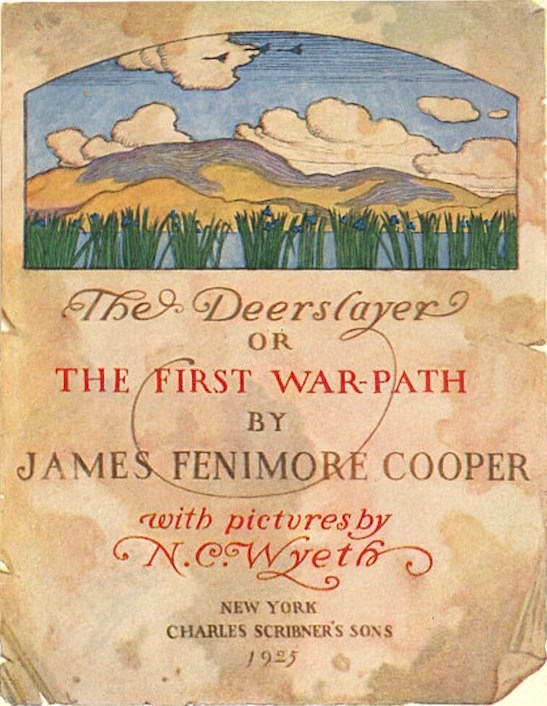














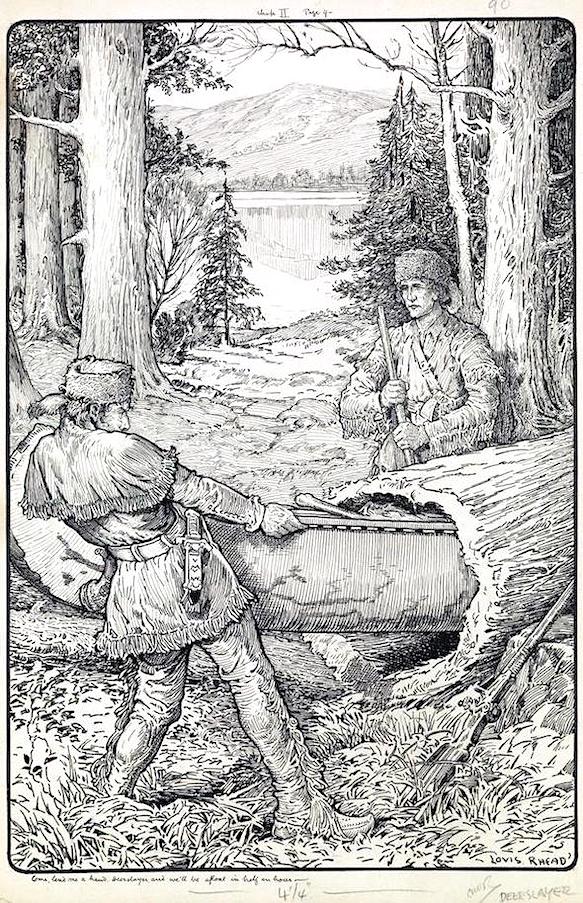








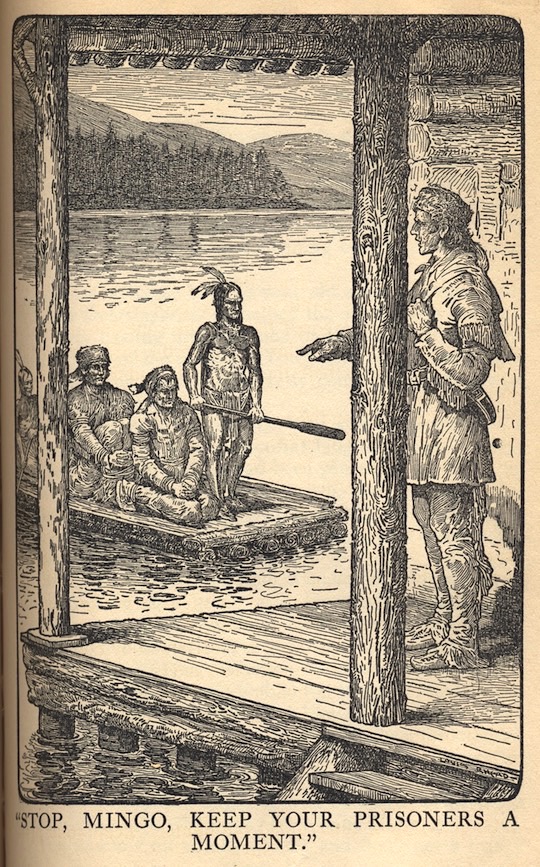
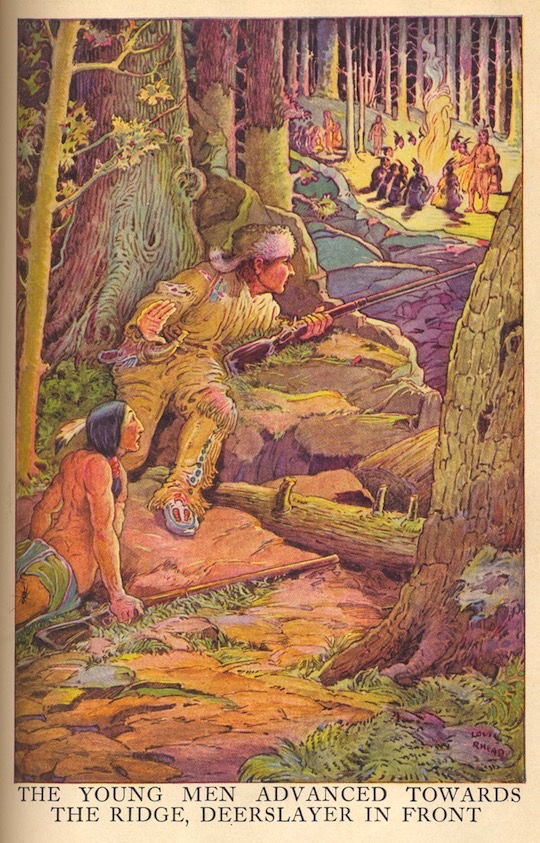


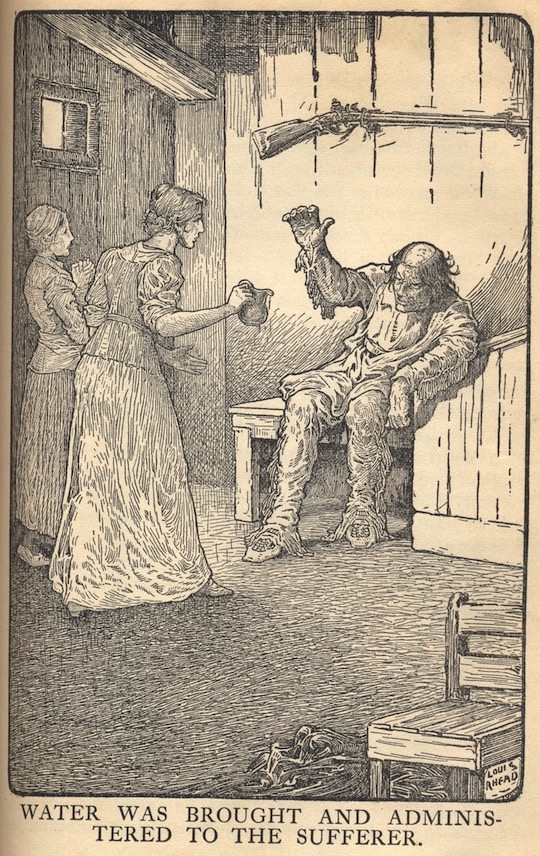













4 comments:
Another great post. Thanks!
Thanks Bob. Part 3 will feature covers and illustrations from Cooper's LAST OF THE MOHICANS.
Excellent post. Thank you.
Thank you! I loved this overview and am looking forward to your profile of "The Last of the Mohicans." I'm currently reading the Leatherstocking Tales now and your insights and collection of artwork is very helpful.
Post a Comment